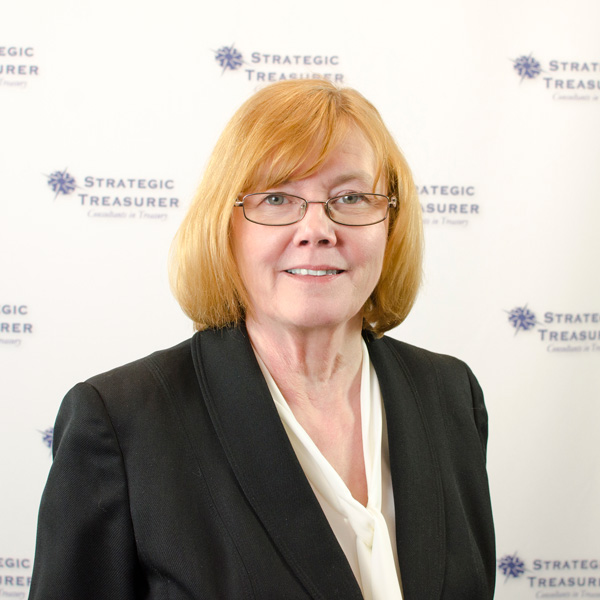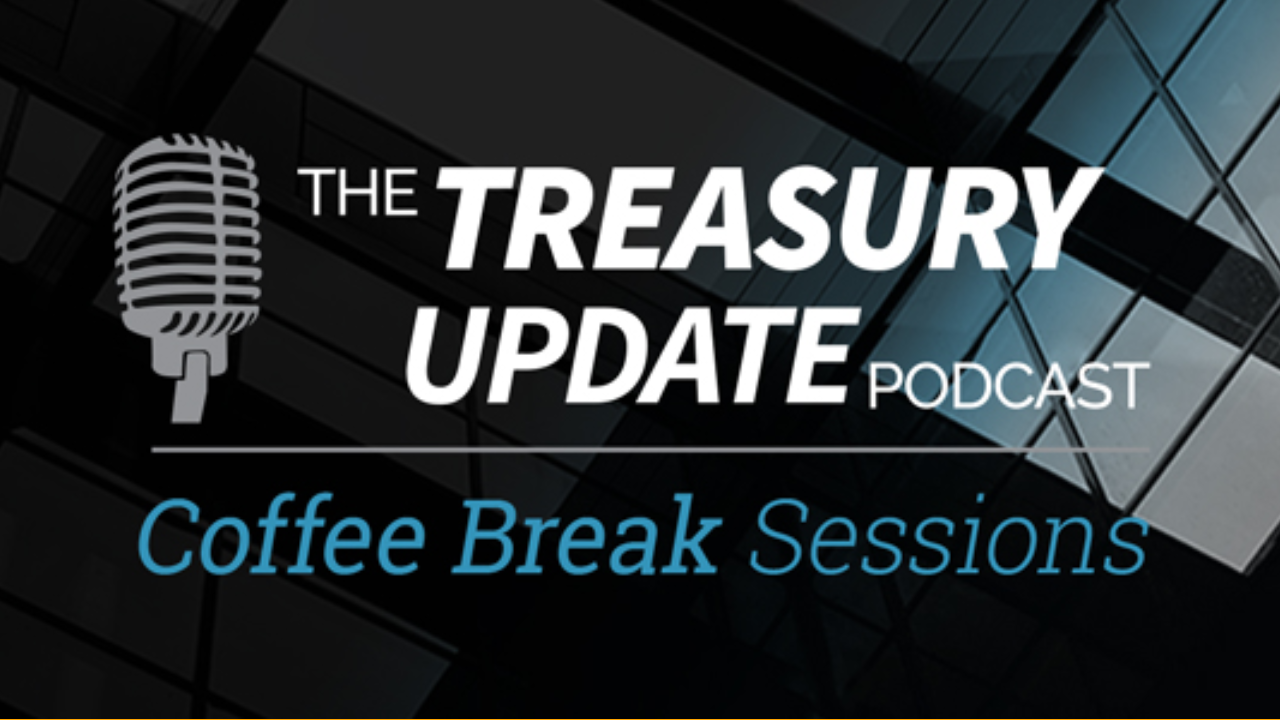
Session 20
What Is a Treasurer?
What is a treasurer? Coffee Break Session Host Alexa Cook talks with colleague Melody Hart, Senior Consultant at Strategic Treasurer, to discuss the profession of a treasurer. Learn what is common for treasurer’s to do, some pathways to become a treasurer and more around their important role. Listen in and learn a little bit about treasurers.
Host:
Alexa Cook, Strategic Treasurer


Speaker:
Melody Hart, Strategic Treasurer


Episode Transcription - CBS Episode 20: What is a Treasurer
INTRO:
Hey guys, welcome to the Treasury Update Podcast, Coffee Break Session. The show where we cover foundational treasury topics and questions in about the same amount of time it takes you to drink your coffee. This is your host Alexa, and today I am joined again by Melody Hart, a senior consultant with Strategic Treasurer. Thank you for joining me, Melody.
Melody:
Hi Alexa. Thank you for inviting me.
Alexa:
Of course. So today we’re going to be covering what is a treasurer? And I think Melody is an excellent person to join me for this topic. So, I guess we can get started with what does a treasurer do when they finally become a treasurer?
Melody:
Well, other than the key areas, I mean, because we all know that treasury has cash management, foreign exchange, debt, investment, that type of thing. But I would kind of put it in more general terms. The key areas that you have to have, is you have to have a knowledge of treasury, you have to have a good mindset, you have to be able to set boundaries and expectations, and you have to have an ability to advocate for treasury, and ability to understand the business, and to be a strategic partner with the businesses. It’s more than just doing the work of treasury. It’s a much broader role.
Alexa:
Okay. So it sounds like when you are a treasurer, you do treasury, but you also are really more of an advocate and you’re doing a much bigger piece of the puzzle. So, that’s good.
Melody:
Yes, yes. You usually are oversight of the treasury, but you have a much, much broader scope.
Alexa:
What are some of the key areas of knowledge that the treasurer should have and the mindset that maybe you would come with that?
Melody:
Well, to be a treasurer, you don’t have to have a deep expertise, in every area of treasury. I mean, if you think of it, a treasurer can come from all kinds of areas. They can come out of FPNA, out of controllers group, or they can come from treasury. You need to know enough about all of the areas, but you don’t have to have depth in the area.
Melody:
So it’s important you’re well-rounded, and most treasurers may have depth in one area, which is where they might’ve started in treasury at one point and got really in depth with it. But then they get a broader knowledge of other areas of treasury. On mindset, there’s two types of thinkers. There’s linear thinkers and global thinkers. A linear mindset has to see things in order. And that means the person will be very good with risk, on things where you have to get it right. A global mindset means a person could take a lot of data in and put together in a rubric to quantify risk and issues. So a treasurer has to be able to look globally across the organization, quantified at a macro level. Now this doesn’t mean that a linear thinker can never be a treasurer. No they can. They have to broaden their mindset as they move up.
Alexa:
What are some of the boundaries that a treasurer might need to set?
Melody:
Well, the first thing is that it’s important to communicate and set boundaries on, is to let people know that treasury owns cash. Now there are different views. Some people and some treasury departments could be looked at as being an observer of cash, which is a passive, inactive, treasury. They’ll report on it, but they aren’t really doing something actively with it. They can be an overseer, who looks and make suggestions about cash, or they can be the owner, the person who controls the cash, and this can be done, whether the company is centralized or not.
Melody:
You have to think of also, who controls relationships to the bank? It should be treasury, debt, and equity structured, global risk interest rate, risk management, payment, security process. Treasury has to own cash and all these processes of how they move funds in most efficient ways and secure ways. It’s important to communicate that treasury is a partner. That a partner to the businesses is to help them grow and succeed in their goals. So treasury has to look at their ideas, but be the adult in the room. So that means you speak up about risk when you see it and you find ways while mitigating risks to accomplish what the business is trying to accomplish. And those successes then must be communicated across functions and businesses to build the credibility of treasury. So many departments and business units really do not understand what treasury is. It’s up to the treasurer to educate them.
Melody:
They need to understand what treasury is. That you manage the balance sheet debt and capital structure, you develop it to meet the needs of the organization, which means also that business units needs. You develop relationships, and you partner with organizations that will take the company to where it needs to be over time and over treasurers. You also make sure the organization has the liquidity it needs. So, that’s some of the boundaries you have to set. Risk management bring your exposures in line with the risk appetite. Now there’s risk appetite, there’s risk tolerance, and there’s risk capacity. Risk capacity is the largest loss or fluctuation that accompany can bear, its maximum level. Risk tolerance is what’s often quoted by a company. It’s stated in the organization, but it’s really the point at which people get nervous or upset when it’s breached. So you have to look at risk appetite. And risk appetite is what the company is actually comfortable in handling in terms of exposure. You have to set the boundaries on that as well.
Alexa:
So what does it mean to be a strategic partner with the other business units or departments?
Melody:
Well, you need to probe their goals and objectives. You need to form a relationship with them, determine what those goals and objectives are and how you could help them meet them. This can take a lot of different routes. So let me give an example. At one company I was with, we were not investment grade and we had very stringent covenants, many agreements globally, each that would cross default each other, including private placements. Any initiatives involving investments, divestitures, dividends, debt, liens, anything like that had to flow through treasury for approval, so that we could make sure that they were not going to end up creating a default for us. So rather than just review the agreements and tell them, “Sorry, this won’t work with our debt agreements, so forget about it“. We would look at what alternatives there were, that they could use to accomplish it and still keep us within our compliance. So it was finding ways to make their project work that were slightly different than what they had proposed, in terms of funding or how it was going to be structured.
Alexa:
So what are some things that treasurers should do when they become a treasurer?
Melody:
Well, I guess let’s talk about the first three to six months in the first year. When you become a treasure, the honeymoon does not last long. So it’s important that you have quick hits and that you know what you’re getting into. So it’s important to assess treasury. That’s one of the first things you should do. So that you can discover the flaws and their security or issues of controls and find any skeletons in the closet. Because if you don’t do that right away, when the honeymoon’s over those skeletons become yours. On a full assessment of treasury, that’s what should do, you talking to people inside and outside of treasury, you’re examining it, you’re observing so that you understand the risks and the processes. You can use a consulting firm to do this. You can do it on your own or maybe one of your banks might offer to help.
Melody:
One of the methods I used to use along with an assessment, was I would create a 90 day plan. And I would detail for the CFO, what I would accomplish in that 90 days. And then I would provide weekly updates on that plan and meeting those objectives, even providing the sub points of, what we’ve gotten this far, and done this. At the end of the 90 days, I provided a full report plus had a proposal for the next 90 day plan. And that’s a good method to document your accomplishments, no matter what level you’re at. And the assessment will tie into it because you can put some of those items into your 90 day plan.
Alexa:
Okay. So you speak about this assessment. What does this assessment accomplish?
Melody:
Well, it should identify the major risks and the major opportunities. You should rank and prioritize the risks and opportunities and come up with a timeline to get it done. It’s important that assessment that you actually address all the areas of treasury, but you should also assess your technology and your payment security, as well as your banking structure and services. There’ve been massive changes in technology in recent years. And many, many treasurers currently are planning for updated tech. This would be a multiyear plan, addressing tech, addressing security, addressing controls, addressing structure. So it’ll take a while, figure out the structure of the tech you need. You cannot survive on 15 year old technology or on Excel spreadsheets. On payment security, this is a tremendous area of exposure and most organizations are not treating it as seriously as they should. When you’re looking at payment security, you need to look not just at your treasury payments, but everyone else’s payments in the company. That means AP, that means payroll, and any other area that might be assuring payments to make sure that there is security there so you don’t suffer a loss.
Alexa:
Okay. So what about the people aspect of treasury? What would maybe need to be done there?
Melody:
Yeah. You need to develop your team and your alliances. For your team, you want to get the right players in the organization who are versatile. Another mindset is to have the people who fit into the organization at that time. Because at different stages of an organization, you may need different people to be involved. If you’re a smaller company, usually you need a really versatile team because you have to wear many hats. If your company becomes very big, that may not fit so well because it means that you might need someone more specialized. So it’s important to know what you need.
Melody:
And each person you have to coach, you have to know how they like to be coached. Some people like to be kind of given a little leeway, other people like a lot of direction. So you know how to speak with that person, and get them into the team. Part of your role as a leader is to make sure people are challenged enough, because if they’re not challenged, they kind of get stuck and they stagnate. So you want to make sure that they feel challenged and that makes them more of a participant in the organization. When a company has a lot of change, it needs people who can adapt quickly, and your team should just should be just that. A team who collaborates and works together toward the goals to help the company. I remember early in my career, I had a boss that allowed me to have a say so in my objectives.
Melody:
But he would always put in as an objective for me to come up with one good new executable idea each year and to implement it. And that guided me to become creative about things and always look at things to see, what else can I change and make better? So, that was a way of, he managed me, to get me to be the participant.
Alexa:
Maybe you could talk a little bit more about the alliances that you had mentioned.
Melody:
Oh sure. There are people within the organization, and in treasury, you touch a lot of areas and it’s very important that you form alliances, people you can work with and who will be there in your camp. So the highest success in treasury comes when you work with people within the organization and also with external organizations. Talk to your internal customers and talk to those, to whom you are a customer as well. Find out what’s on their plate, find out what their paying points are, find out what they need from you, and how you can help them.
Melody:
And if you help any of these individuals be successful, you build and protect alliances that will help you be successful. So for instance, if you’re trying to adopt or put in place policies, you may need to get an area that is effected by it, to opt in. You need to make sure it works. So getting that feedback helps the success of the policy. Once that one is successful, new changes may come around more readily after success because you have built trust in the organization. Eventually the most resistant will have to come along and as you’re successful and you build a record of success, you’ll find that people are much more willing to hop on your project because they know that you’re going to be successful.
Alexa:
That makes sense. So I’m going to do a quick recap of what we’ve covered today. Treasurers typically have an oversight of treasury and they’re very big on relationship management. And I think you said that they’re an educator of what treasury is and that’s really from a balance sheet perspective. And they’re in charge of taking care of liquidity. And I think you said that they should do an assessment of their treasury and kind of know what they have and what they’re working with. And that’s not just from a true treasury and cash perspective or a systems perspective, that’s also applicable to their team and their alliances, kind of the relationship management, whether that’s internally or externally. And then the treasury owns cash. And was there anything else that you wanted to add? Or are there any other areas of consideration?
Melody:
Well, back on the communications page, yes, there would be some. One thing that is good for treasury to do is to get KPIs, key performance indicators. And the treasurer will have to decide on what those are. It could be performance of operations, it could be on liquidity, risks, security, or projects. It’s what drives treasury for your company. If you’re a high, really leveraged company, that’s international, you may focus on liquidity, risk, and cost of capital, more than the other areas. If you’re retail, operational efficiency may be key for you. The first step is to determine the drivers, select the measurements that highlight the department based on those drivers, and then do the measurements on a regular basis and publish them.
Alexa:
Perfect. Well, thank you, Melody. I think that sums up what a treasurer does and I guess a little bit about what is treasury. So thank you for joining me today, I appreciate your time. And to all of our listeners, make sure you tune back every first and third, Thursday of the month for a new episode. And as always, if you have any comments, questions, or topic ideas, please feel free to send us an email at podcast@strategictreasurer.com. Thanks again, Melody.
Melody:
Thank you, Alexa.
OUTRO:
This podcast is provided for informational purposes only. And statements made by Strategic Treasurer, LLC on this podcast are not intended as legal, business, consulting, or tax advice. For more information visit and bookmark strategictreasurer.com.
Related Resources
Want access to more great content? Subscribe to Strategic Treasurer on YouTube!
A part of the Treasury Update Podcast, Coffee Break Sessions are 6-12 minute bite-size episodes covering foundational topics and core treasury issues in about the same amount of time it takes you to drink your coffee. The show episodes are released every first and third Thursday of the month with Special Host and Treasury Consultant Alexa Cook of Strategic Treasurer.




